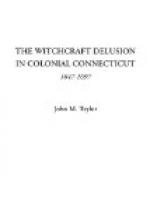Here and there in New England, following the great immigration from Old England, from 1630-40, during the Commonwealth, and to the Restoration, several cases of witchcraft occurred, but the mania did not set its seal on the minds of men, and inspire them to run amuck in their frenzy, until the days of the swift onset in Massachusetts and Connecticut in 1692, when the zenith of Satan’s reign was reached in the Puritan colonies.
A few words about the tragedy at Salem are relevant and essential. They are written because it was the last outbreak of epidemic demonopathy among the civilized peoples; it has been exploited by writers abroad, who have left the dreadful record of the treatment of the delusion in their own countries in the background; it was accompanied in some degree by like manifestations and methods of suppression in sister colonies; it was fanned into flames by men in high station who reveled in its merciless extirpation as a religious duty, and eased their consciences afterwards by contrition, confession and remorse, for their valiant service in the army of the theological devil; and especially for the contrasts it presents to the more cautious and saner methods of procedure that obtained in the governments of Connecticut and New Haven at the apogee of the delusion.
What say the historians and scholars, some of whose ancestors witnessed or participated in the tragedies, and whose acquaintance with the facts defies all challenge?
“It is on the whole the most gruesome episode in American history, and it sheds back a lurid light upon the long tale of witchcraft in the past.” (Fiske’s New France and New England, 195.)
“The sainted minister in the church; the woman of the scarlet letter in the market place! What imagination would have been irreverent enough to surmise that the same scorching stigma was on them both.” (Scarlet Letter, HAWTHORNE.)
“We are made partners in parish and village feuds. We share in the chimney corner gossip, and learn for the first time how many mean and merely human motives, whether consciously or unconsciously, gave impulse and intensity to the passions of the actors in that memorable tragedy which dealt the death blow in this country to the belief in Satanic compacts.” (Among my Books—Witchcraft, p. 142, LOWELL.)
“The tragedy was at an end. It lasted about six months, from the first accusations in March until the last executions in September.... It was an epidemic of mad superstitious fear, bitterly to be regretted, and a stain upon the high civilization of the Bay Colony.” (Historic Towns of New England, Salem, p. 148, LATIMER.)
What was done at Salem, when the tempest of unreason broke loose? Who were the chief actors in it? This was done. From the first accusation in March, 1692, to the last execution in September, 1692, nineteen persons were hanged and one man was pressed to death[D] (no witch was ever burned in New England), hundreds of innocent men and women were imprisoned, or fled into exile or hiding places, their homes were broken up, their estates were ruined, and their families and friends were left in sorrow, anxiety, and desolation; and all this terrorism was wrought at the instance of the chief men in the communities, the magistrates, and the ministers.




